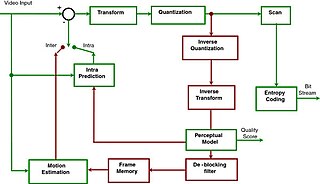Related Research Articles
H.263 is a video compression standard originally designed as a low-bit-rate compressed format for videotelephony. It was standardized by the ITU-T Video Coding Experts Group (VCEG) in a project ending in 1995/1996. It is a member of the H.26x family of video coding standards in the domain of the ITU-T.

The Moving Picture Experts Group (MPEG) is an alliance of working groups established jointly by ISO and IEC that sets standards for media coding, including compression coding of audio, video, graphics, and genomic data; and transmission and file formats for various applications. Together with JPEG, MPEG is organized under ISO/IEC JTC 1/SC 29 – Coding of audio, picture, multimedia and hypermedia information.

MPEG-2 is a standard for "the generic coding of moving pictures and associated audio information". It describes a combination of lossy video compression and lossy audio data compression methods, which permit storage and transmission of movies using currently available storage media and transmission bandwidth. While MPEG-2 is not as efficient as newer standards such as H.264/AVC and H.265/HEVC, backwards compatibility with existing hardware and software means it is still widely used, for example in over-the-air digital television broadcasting and in the DVD-Video standard.
MPEG-4 is a group of international standards for the compression of digital audio and visual data, multimedia systems, and file storage formats. It was originally introduced in late 1998 as a group of audio and video coding formats and related technology agreed upon by the ISO/IEC Moving Picture Experts Group (MPEG) under the formal standard ISO/IEC 14496 – Coding of audio-visual objects. Uses of MPEG-4 include compression of audiovisual data for Internet video and CD distribution, voice and broadcast television applications. The MPEG-4 standard was developed by a group led by Touradj Ebrahimi and Fernando Pereira.
Advanced Audio Coding (AAC) is an audio coding standard for lossy digital audio compression. It was designed to be the successor of the MP3 format and generally achieves higher sound quality than MP3 at the same bit rate.

Advanced Video Coding (AVC), also referred to as H.264 or MPEG-4 Part 10, is a video compression standard based on block-oriented, motion-compensated coding. It is by far the most commonly used format for the recording, compression, and distribution of video content, used by 91% of video industry developers as of September 2019. It supports a maximum resolution of 8K UHD.
MPEG-4 Part 3 or MPEG-4 Audio is the third part of the ISO/IEC MPEG-4 international standard developed by Moving Picture Experts Group. It specifies audio coding methods. The first version of ISO/IEC 14496-3 was published in 1999.
H.262 or MPEG-2 Part 2 is a video coding format standardised and jointly maintained by ITU-T Study Group 16 Video Coding Experts Group (VCEG) and ISO/IEC Moving Picture Experts Group (MPEG), and developed with the involvement of many companies. It is the second part of the ISO/IEC MPEG-2 standard. The ITU-T Recommendation H.262 and ISO/IEC 13818-2 documents are identical.
MPEG-4 Part 2, MPEG-4 Visual is a video compression format developed by the Moving Picture Experts Group (MPEG). It belongs to the MPEG-4 ISO/IEC standards. It uses block-wise motion compensation and a discrete cosine transform (DCT), similar to previous standards such as MPEG-1 Part 2 and H.262/MPEG-2 Part 2.
MPEG-4 Part 11Scene description and application engine was published as ISO/IEC 14496-11 in 2005. MPEG-4 Part 11 is also known as BIFS, XMT, MPEG-J. It defines:

MPEG-4 SLS, or MPEG-4 Scalable to Lossless as per ISO/IEC 14496-3:2005/Amd 3:2006 (Scalable Lossless Coding), is an extension to the MPEG-4 Part 3 (MPEG-4 Audio) standard to allow lossless audio compression scalable to lossy MPEG-4 General Audio coding methods (e.g., variations of AAC). It was developed jointly by the Institute for Infocomm Research (I2R) and Fraunhofer, which commercializes its implementation of a limited subset of the standard under the name of HD-AAC. Standardization of the HD-AAC profile for MPEG-4 Audio is under development (as of September 2009).

MPEG-4 Part 14, or MP4, is a digital multimedia container format most commonly used to store video and audio, but it can also be used to store other data such as subtitles and still images. Like most modern container formats, it allows streaming over the Internet. The only filename extension for MPEG-4 Part 14 files as defined by the specification is .mp4. MPEG-4 Part 14 is a standard specified as a part of MPEG-4.
BiM is an international standard defining a generic binary format for encoding XML documents.
High Efficiency Video Coding (HEVC), also known as H.265 and MPEG-H Part 2, is a video compression standard designed as part of the MPEG-H project as a successor to the widely used Advanced Video Coding. In comparison to AVC, HEVC offers from 25% to 50% better data compression at the same level of video quality, or substantially improved video quality at the same bit rate. It supports resolutions up to 8192×4320, including 8K UHD, and unlike the primarily 8-bit AVC, HEVC's higher fidelity Main 10 profile has been incorporated into nearly all supporting hardware.
The ISO base media file format (ISOBMFF) is a container file format that defines a general structure for files that contain time-based multimedia data such as video and audio. It is standardized in ISO/IEC 14496-12, a.k.a. MPEG-4 Part 12, and was formerly also published as ISO/IEC 15444-12, a.k.a. JPEG 2000 Part 12.
ISO/IEC JTC 1/SC 29, entitled Coding of audio, picture, multimedia and hypermedia information, is a standardization subcommittee of the Joint Technical Committee ISO/IEC JTC 1 of the International Organization for Standardization (ISO) and the International Electrotechnical Commission (IEC). It develops and facilitates international standards, technical reports, and technical specifications within the field of audio, picture, multimedia, and hypermedia information coding. SC 29 includes the well-known JPEG and MPEG experts groups, and the standards developed by SC 29 have been recognized by nine Emmy Awards.
High Efficiency Image File Format (HEIF) is a container format for storing individual digital images and image sequences. The standard covers multimedia files that can also include other media streams, such as timed text, audio and video.
Versatile Video Coding (VVC), also known as H.266, ISO/IEC 23090-3, and MPEG-I Part 3, is a video compression standard finalized on 6 July 2020, by the Joint Video Experts Team (JVET), a joint video expert team of the VCEG working group of ITU-T Study Group 16 and the MPEG working group of ISO/IEC JTC 1/SC 29. It is the successor to High Efficiency Video Coding. It was developed with two primary goals – improved compression performance and support for a very broad range of applications.

Low Complexity Enhancement Video Coding (LCEVC) is a ISO/IEC video coding standard developed by the Moving Picture Experts Group (MPEG) under the project name MPEG-5 Part 2 LCEVC.
References
- ↑ Leonardo Chiariglione (January 28, 2018). "A crisis, the causes and a solution".
- ↑ "IEC - Members & experts > Info: Patents > IEC Patent Declarations > Common patent policy for ITU-T / ITU-R / ISO / IEC". www.iec.ch.
- 1 2 3 4 5 Wang, Ronggang; Wang, Zhenyu; Fan, Kui; Huang, Tiejun; Wang, Wenmin; Li, Ge; Gao, Wen (2018). "MPEG Internet Video Coding Standard and its Performance Evaluation". IEEE Transactions on Circuits and Systems for Video Technology. IEEE Xplore. 28 (3): 719–733. doi:10.1109/TCSVT.2016.2631249. S2CID 3703279.